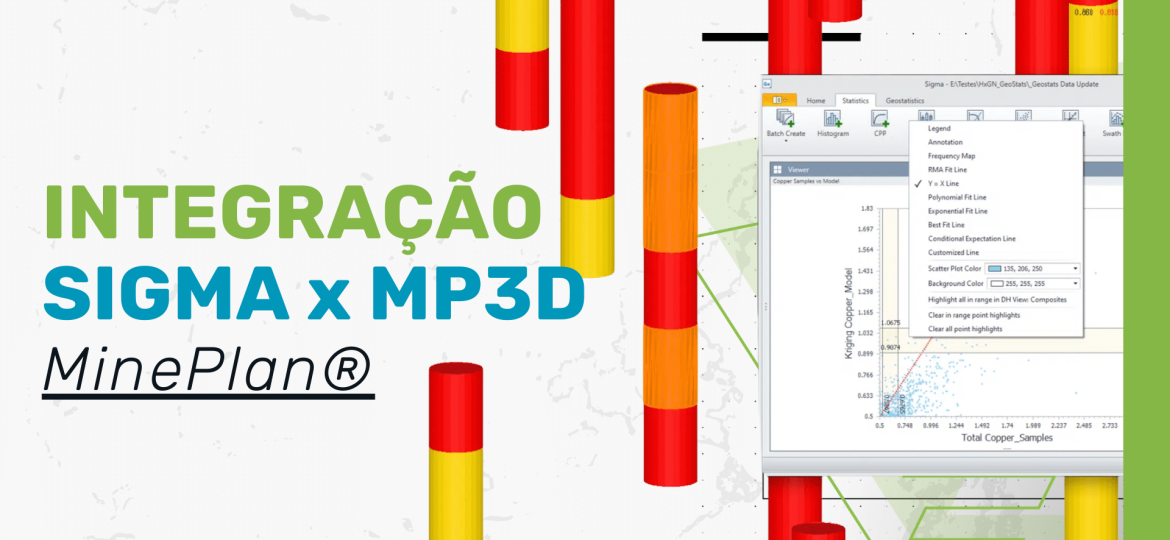Geostatistics based on variogram allows to generate two types of block model: Estimated and simulated. Estimated models depend on the implementation of kriging methods to calculate the mean and variance of each attribute of interest in each block. A wide range of kriging methods can be implemented, including universal kriging, ordinary kriging, and simple kriging. Each of these methods is designed for a specific purpose. Simulated models rely on implementing Gaussian-based simulation methods, including sequential Gaussian simulation (SGS), LU simulation, and tuning band simulation, to generate equally likely deposit scenarios that honor the drillhole data. Any of these Gaussian-based simulation methods are expected to generate the same type of realizations for a given variographic model. These methods are different in the way they deal with computational resources based on the amount of data and the size of the deposit. The mean and variance map of the realizations are expected to be similar to simple kriging on a Gaussian scale.
The decision to build an estimated or simulated model depends on the type of evaluation required. An estimated model makes it possible to calculate an estimate of a deposit's mineral reserve. A simulated model makes it possible to calculate different equally likely scenarios for a mineral reserve in the deposit, which serves to assess the risks of a mining project. Different aspects need to be considered before planning to use a simulated model to evaluate a warehouse:
1 – The calculation of the variography is time consuming, since it is less tolerant than in the case of an estimated model, since it needs to be numerically validated;
2 – Unlike an estimated model, where the geological models are interpreted, in the simulation the geological model needs to be simulated together with the continuous attributes;
3 – In the presence of more than two dependent variables, the attributes need to be simulated together to preserve the dependency relationships, thus increasing the complexity of model construction;
4 – Mine planning methods based on estimated models are not applied directly to simulated models.
In different fields of engineering, simulation is the preferred analysis framework for designing solutions to studied problems due to the complexities of the environment considered. For example: planes are designed to simulate different flight conditions; the deformation of anti-seismic building structure models is tested by simulating earthquake conditions; the viability of oil projects is analyzed by geological simulations and the behavior of oil reserves. So the valuation of a mineral deposit is no different. The mineral reserves of a deposit are sensitive to variations in the geology of the deposit. During deposit assessment, it is important to know how the mine plan will be affected by these potential variations. This type of analysis is not possible using estimated models.
Working behind the curtains
A simulated model consists of a set of equally probable realizations of the warehouse. In each realization, all relevant attributes considered in the warehouse evaluation are simulated. These attributes can be summarized into two categories:
- Categorical
- Continuous
An example of a categorical and continuous attribute is rock type and metal grade, respectively. Categorical attributes are based on simulating continuous attributes, usually because these first define the domain boundaries. Characteristically, categorical attributes are simulated first in order to define domains that will be used later to simulate continuous attributes. Achievements are generated on a point scale. The mesh of the places where the realizations are generated are considered to be the discretized configuration of the block model. After simulating all the attributes, the realizations are submitted to the block specifications.
Simulation of categorical attributes
There are many techniques for simulating categorical attributes. The most popular is the sequential indicatrix simulation. In this technique, the spatial variability of geological features is captured by an array of indicator variograms.
The workflow for implementing indicatrix simulation can be summarized as follows:
- Estimate of global proportions: The objective is to find proportions of occurrence of each geological category in the deposit. These ratios cannot be inferred directly from the borehole data because of the preferential sampling nature of drilling campaigns. Ideally, these proportions are inferred by experienced geologists with a good understanding of the deposit.
- Variography calculation: A set of variographic models is calculated after transforming each category to indicators. For each category applies:
1 – The compounds of the category used are coded as 1 or 0;
2 – An experimental variogram is calculated based on the binary data;
3 – The experimental variogram is modeled.
- Generation of simulations (realizations): a set of realizations is generated based on the set of variographic models. At least 50 realizations must be generated to properly characterize the relevant response distribution of the analyzed variables, including ore tonnage, contained metal, and project revenue. Specific features of large-scale geological structures are represented in the realizations, considering trend information for each category.
- Validation of achievements: achievements are visually and numerically validated. The visual validation consists of checking the realization in relation to its geological characteristics. Numerical validation consists of verifying the reproduction of global proportions.
Reproduction of geological features largely depends on additional trend maps. In practice, these maps are interpreted manually. Trend maps allow dealing with information from large and medium scale geological structures. However, small-scale structures are difficult to characterize. Alternatively, there are more complex techniques, such as multipoint geostatistical simulation, which focus especially on reproducing geological structures at different scales. These techniques do not rely on variograms to characterize geological features of the deposit.
Simulation of continuous attributes
To simulate continuous features, the drilling data needs to be transformed to Gaussian scale. The reason for this transformation is the convenient properties of stationary multi-Gaussian random functions that make the simulation possible. In this structure of stationary multi-Gaussian random functions, all calculated conditional distributions and combination of distributions are always Gaussian. Conditional distributions can be calculated by implementing simple kriging, since Gaussian distributions are parameterized only by mean and variance. The realization can be sampled from a Gaussian distribution due to full knowledge of the shape of the distribution. Thus, it is for this reason that Gaussian simulation is practical. To use the data in original units (without transformation), knowing the mean and variance of the conditional distribution is not enough to sample the realizations, because the total form of the conditional distribution is unknown. (Figure 1)
Some authors propose different alternatives to implement simulation in original units, without using the Gaussian transformation. These methods are not practical because of the large assumptions made.
The workflow for simulating continuous attributes within a domain can be summarized as:
- Declustering: this step is to calculate a referential distribution of the attribute in original units. This referential distribution is important as it will later be needed when transforming the data from original units to Gaussian and vice versa.
- Transformation of normal results: the drilling data of a domain are transformed to Gaussian scale based on the reference distribution in original units.
- Variography calculations: the variographic model of attributes is calculated based on Gaussian scale drilling data. The variographic model is validated using cross-validation to test conditional distributions at composite sites. The estimated probabilities should be similar to your borehole data probabilities for the calculated conditional distributions.
Generation of realizations: a set of realizations is generated based on composite data on a Gaussian scale and their respective variograms. A continuous attribute realization is generated for each categorical attribute realization.
- Validation of achievements: the realizations are validated based on the reproduction of the variographic models. The average of the experimental variograms of each realization is expected to be similar to the variographic model used to generate the realizations.
Additionally, the overall mean and variance of each achievement are expected to be close to zero and one respectively.
- Transformation of realizations into original unit: information from a simulated model that is used in warehouse valuation needs to be transformed into original units. The transformation is done based on the referential distribution calculated in the declustering step. Validation consists of comparing the mean of the global realization distributions and the reference distribution of the composite data.
In the presence of multiple dependent attributes, the workflow requires the implementation of co-simulation techniques. In practice, two attributes are considered dependent if the absolute value of the correlation coefficients is greater than 0.5. Depending on the number of existing dependent attributes, different co-simulation techniques can be implemented, including co-localized simulation, full co-simulation, and phased conditioning.
The generation of a simulated model is more demanding than the generation of an estimated model, since both types of attributes (geological and grade) need to be simulated. The realization of a point-scale deposit consists of all realizations for both categorical and continuous attribute types (Figure 2). In the case of an estimated model, categorical attributes are manually interpreted and continuous attributes are estimated. In a simulated model, categorical attributes cannot be replaced by a geological model because this could introduce bias in the characterization of the distribution of response variables.
Figure 3 shows an example of a realization of a deposit consisting of two attributes, rock type and total copper. Categorical and continuous attribute realizations are generated using MineSight Compass routines.
- pscsis.dat – Sequential simulation by indicator;
- pscsgs.dat – Gaussian sequential simulation.
The realizations of the total copper attribute are formatted for the block using the MSCompass routine called pblock.dat
- pblock.dat – transformation of the point data of the realizations to the block dimension.
These MSCompass routines are combined into a multi-run to automate the generation of warehouse realizations. The realizations for both attributes reproduce the spatial variability captured in their respective variographic models. This is not the case for estimated models in which their attributes are smoothed. If not properly corrected, attribute smoothing introduces bias in the deposit assessment. For example, a grade and tonnage curve cannot be properly calculated.
Processing the simulated model to evaluate the deposit requires different techniques from the traditional estimated model. For example, to assess the mineral reserve inventory, it is not good practice to calculate the final pit for each realization and plot a histogram of the ore inventory. This calculation overestimates the potential of the deposit because it is assumed that the deposit can be mined perfectly.
What's more, it would be hard to know what the final pit would be for the project. An appropriate means of estimating resources would be a study of different alternatives for the final pit. In this context, the final pit alternatives would have to aim to maximize profit and at the same time take into account economic losses due to mining errors. The deposit realizations allow to calculate the mining error due to the presence of geological uncertainty.
Conclusion
Simulation is the current approach in many fields of engineering to design solutions to studied problems. Valuing a mineral deposit is no different. Ideally, the performances of alternative mine plans should be verified against different, but equally likely, deposit scenarios. These different scenarios would allow assessing the impact of geological uncertainty on the performance of mine plans. The estimation paradigm is widely adopted in the mining industry to assess the deposit. The main reason for not considering the simulation paradigm is the complexity and a lot of extra work involved in building the process of simulated models of the deposit.
Simulation techniques can also be implemented in different tasks such as the construction of a model to evaluate the mineral deposit including the design of infill drilling campaigns, the design of medium term plans, and the design of alternative sequencing based on plant requirements. . This additional information could allow geologists and mining engineers to make decisions with much more information about the deposit.
For more information about MineSight tools for simulation and implementation of routines for calculating errors associated with mining, contact client-relations@prominas.net.
To the next!!!




